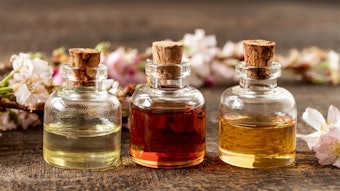What does it take to build and sustain a brand in today’s fine fragrance market reality—and what role does the juice have in that process? These questions were the focus of comments delivered by Christine Dagousset (Chanel, Inc.) and Veronique Gabai-Pinsky (The Estée Lauder Co., Inc.) during Cosmetic Executive Women’s “Time-Defying Scents” panel at New York’s Harmonie Club.
While there are signs of recovery in fine fragrance sales, the market reality has shifted, said Gabai-Pinsky. The global economic crisis of recent years led to a loss of confidence and security, leading consumers to reassess values, beliefs in institutions and what they were truly willing to pay a premium for. As a result, she explained, “There is a strong divide between what people consider luxury and what they consider a commodity; the things in the middle are struggling.”
So what, exactly, is luxury in the post-economic meltdown age? “Luxury has to be anchored in a true knowledge of the product and craftsmanship,” said Gabi-Pinsky. “We have to reassess what we’re giving the consumer when we talk of luxury.” Citing pureDKNY, she explained that investing in brands means luxury must be anchored in “true” craftsmanship. “Tell the story of the juice,” she said. “This is what makes luxury.” Raw materials and creation are at the heart of that story, she added, which evoke pleasure and fun for consumers. “The customer will get back to us because of quality,” she said, adding that when products are launched correctly, the undertaking is less about marketing than it is about passion. And, while continuous market research helps companies such as Estée Lauder and Chanel to address consumer needs based on what is influencing lives and desires, Gabai-Pinsky pointed out that it is in fact the fragrance industry’s business “is about creating wants.”
“Never compromise on quality,” Gabai-Pinsky continued, adding no fragrance should be launched it it’s not ready: “Be true to the brand.” But when is a fragrance ready? Gabai-Pinsky said that a scent is finished when new mods twist away from the perfection that’s been achieved up to that point. Dagousset added that some of the development projects at Chanel, which she characterized as a highly particular house, can take years. Yet, no matter how no matter how long it takes, the mantra never changes: “When it’s ready, it’s perfect.”
Meanwhile, the polarization between commodity and luxury offerings does not mean the classic model isn’t still valid, offering success without brands cannibalizing one another. In fact, Gabi-Pinsky noted, “Maintaining support for classics has been a successful strategy.”
For Coco Mademoiselle, now in its 10th year on the market, Chanel has highlighted the scent’s quality and brand reliability, said Dagousset.
“In the case of Cashmere Mist [launched in 1994], it’s the juice that drives the brand,” said Gabai-Pinsky. The company has invested in regular sampling promotions to inspire new customers for this and other classics, in addition to introducing new deliveries around the juice.
Yet, even as classics continue to drive sales, the power of BRIC countries continues to expand the range of consumer fragrance tastes. Some brands have global appeal, while others will engage localized tastes, said Gabai-Pinsky. But no matter what, brand equity is crucial. The time when brands launched everything everywhere at the same time is done, Gabai-Pinsky continued. Things are no longer homogenized. Tastes in the East vary from the traditions in the West. And while some superpower brands can translate globally, some are bound to be less globally relevant. That’s where a strong portfolio of brands can bolster companies’ international and regional success.
Dagousset and Gabai-Pinsky went on to underscore the crucial role of the experience delivered around products. Declaring the typical US fragrance retail experience as “depressing,” Gabai-Pinsky noted that fragrance’s biggest battle is at retail. Citing Chanel Confidential, which offers glimpses of what happens “behind the brand,” Dagousset said that brands must embrace and accept the consequences of the social media conversation. The consumer relationship, she joked, is a dictatorship. Yet, the danger of losing the ability to seduce consumers makes such risk indispensible.
“We’ve got to go back to what makes us different,” Dagousset concluded. “Fragrances that are special—everybody loves that.”










